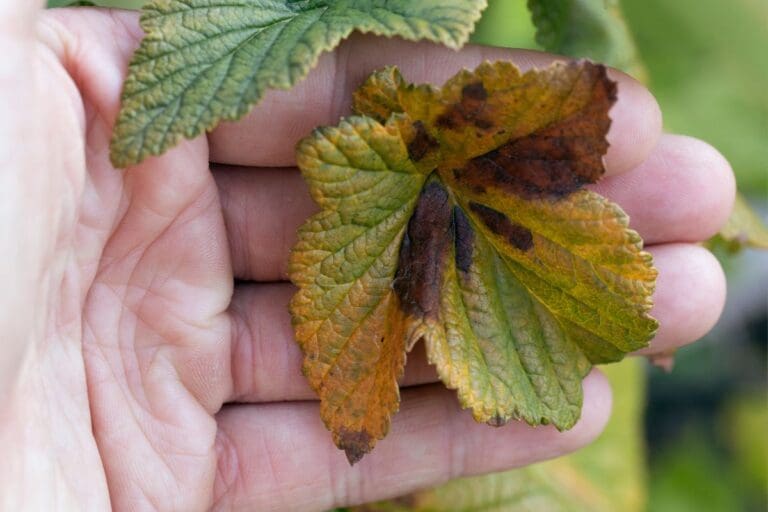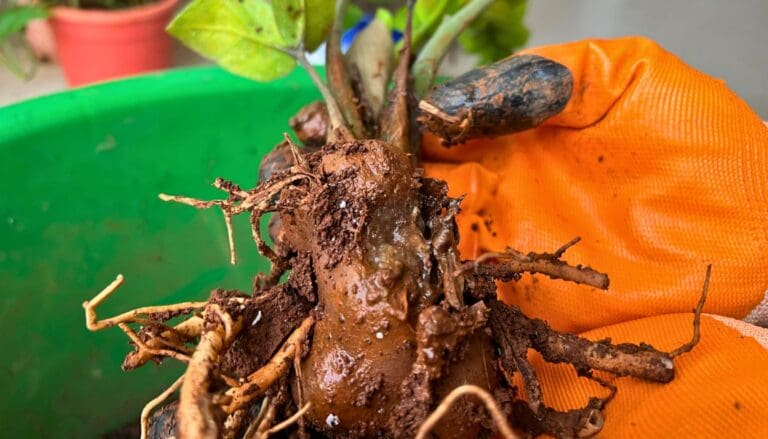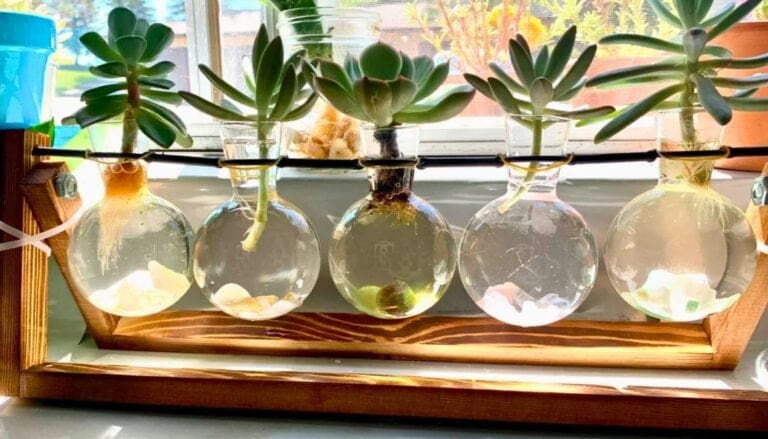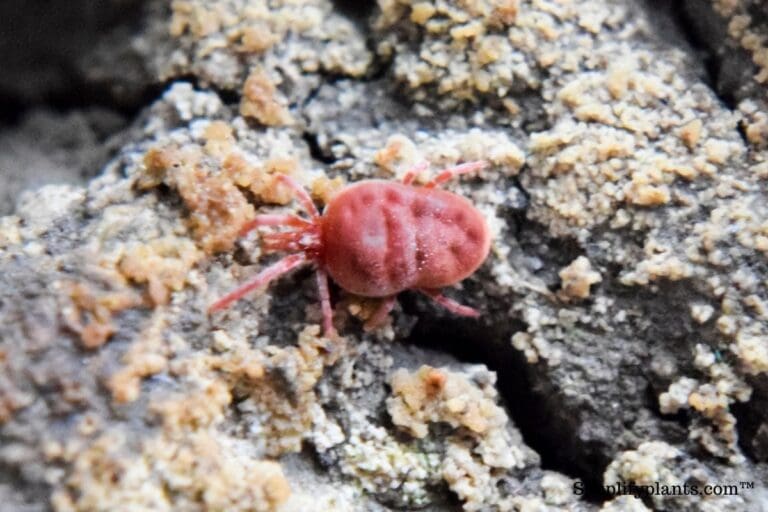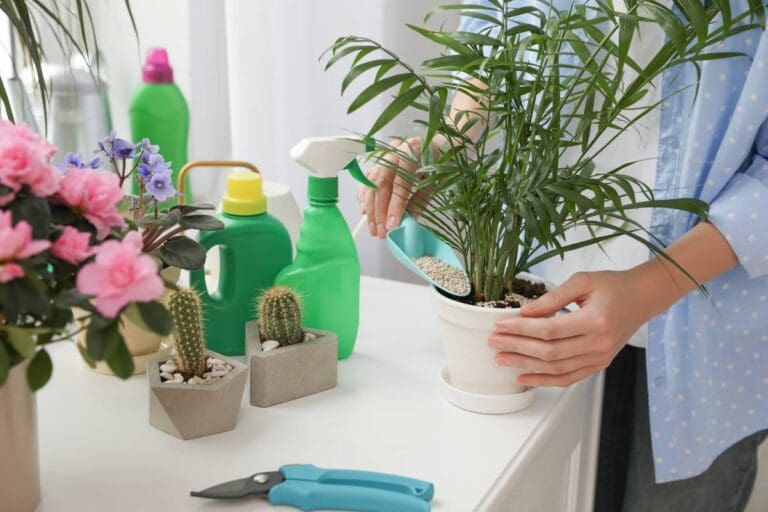My Top 10 Tricks For Growing Miniature Roses Indoors Like A Pro
I’ve always had a soft spot for miniature roses. There’s just something about their charm when they brighten up a room.
Growing them indoors? It takes a bit of care, but honestly, it’s not as tricky as you might think.
With the right light, soil, and a little attention, you can have colorful blooms right on your windowsill, pretty much all year round.
In this article, I’ll let you in on my top tricks for keeping indoor roses happy and thriving. You’ll see how I handle light, watering, and temperature to keep my plants strong and blooming.
Each tip helps set up the perfect indoor environment for these tiny but stunning flowers.
Please note: Simplify Plants is reader-supported. As an Amazon Associate, I earn from qualifying purchases made by our readers with no extra cost added to you all! Some links in the post are affiliate links and I get a commission from purchases made through links in the post.
1) Choose a bright south-facing window

I always put my miniature roses near a south-facing window—it’s just the best spot for sunlight during the day. These little plants crave bright light, and without it, they get all leggy or just stop blooming.
I make sure the window gets at least six hours of direct sunlight every day. If trees or buildings block the light, I’ll move the pot closer to the glass or even put it on a stand.
Sometimes, in the summer, the sun gets a bit too intense. I’ll throw up a light sheer curtain to soften things up so the leaves don’t scorch, but there’s still plenty of brightness.
Winter sunlight can be pretty weak. I’ll add a small grow light a few inches above the plants and flip it on for several hours a day.
I also try to keep the window area clean. I actually wipe the glass regularly so dust doesn’t steal any precious light.
If I notice my plant leaning toward the window, I’ll rotate the pot every few days. It helps keep the growth even and the shape looking good.
A bright south-facing window really does give my miniature roses the boost they need to stay strong and keep flowering all year.
2) Use well-draining cactus or rose potting mix
I always start with a well-draining potting mix meant for cactus or roses. Roots sitting in water? That’s a recipe for rot. Miniature roses like a bit of moisture, but they also need air.
Back when I started, I used regular garden soil. Big mistake—it got way too heavy and wet. Now, I stick with a light mix that lets extra water flow out, and my plants are so much happier.
You can grab special rose potting mixes at most garden centers. They usually have things like perlite, sand, or bark to help drainage. Or, if you’re into DIY, you can mix your own with equal parts potting soil, perlite, and coarse sand.
I always check that my pots have drainage holes before filling them. Even the best soil can’t help if water has nowhere to go.
A tray under each pot catches extra water, and I empty it after watering. Roots need oxygen, so soggy soil is a no-go.
Every year or two, I refresh the soil. Potting mix breaks down over time and loses its texture, so new soil keeps the roots happy.
Honestly, choosing the right soil mix makes a huge difference for indoor miniature roses.
3) Water when the top inch of soil feels dry
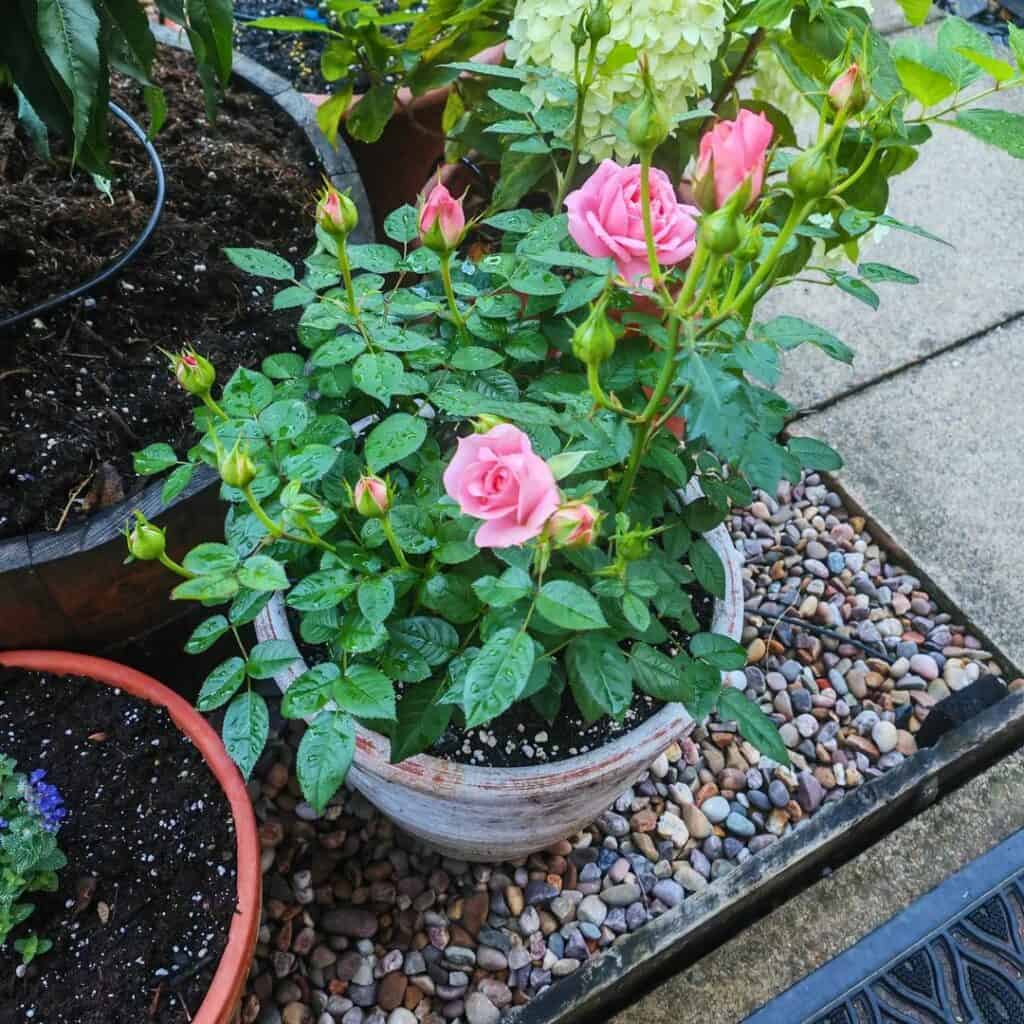
I always check the soil before watering. I’ll stick my finger in about an inch—if it’s dry, I water. If it’s still damp, I just wait a bit longer.
Overwatering leads to root rot, and I definitely learned that the hard way. Now, I let the soil tell me when it’s time, not some calendar.
I pour water slowly until it drains out the bottom. That way, the whole root system gets a drink.
Never let the pot sit in water, though. That’s just asking for soggy roots.
In winter, I water less since the plants grow slower. When it’s warmer, I check more often because the soil dries out faster.
I use a small watering can with a skinny spout to aim water at the base, not the leaves. Wet leaves can attract pests or fungus, so I try to keep them dry.
If I’m not sure, I’ll just lift the pot. A light pot means dry soil, a heavy one means it’s still wet.
Keeping the soil evenly moist—not too wet, not bone dry—has made my miniature roses bloom so much better indoors.
4) Maintain indoor humidity with a pebble tray
I’ve noticed that miniature roses need steady humidity to really thrive indoors. Dry air can make their leaves turn brown or drop.
A simple pebble tray works wonders. I fill a shallow tray with pebbles, add water until it almost covers them, and set the pot on top (without letting it touch the water). As the water evaporates, it adds gentle moisture around the plant.
I check the tray every few days and top up the water if needed. It’s an easy routine, and my roses look fresher for it.
I also make sure there’s good air circulation so things don’t get too stuffy.
Every week or two, I rinse the pebbles to prevent mold. It takes barely any time, but it keeps things clean.
If the air gets super dry in winter, I’ll add a small room humidifier to the mix. That, plus the pebble tray, really helps.
5) Fertilize monthly with a balanced liquid fertilizer

I’ve found that miniature roses need regular feeding to stay healthy and keep blooming indoors. Small pots mean nutrients disappear fast.
A balanced liquid fertilizer keeps growth steady and the leaves nice and green.
I usually go with a 10-10-10 or 20-20-20 formula—it’s got equal parts nitrogen, phosphorus, and potassium, which is just what the plants need.
I mix it with water according to the label, then pour it gently into the soil until it drains out the bottom. Never fertilize dry soil—that can burn the roots.
Once a month is plenty for my roses. If they look pale, maybe I’ll feed a bit sooner, but honestly, too much fertilizer is worse than not enough.
During winter, I cut back or skip a month. The plants just don’t need as much when they’re resting.
I use room-temperature water for mixing, just to avoid shocking the roots.
With a simple schedule and a balanced mix, my miniature roses stay happy, blooming longer and looking fresh.
6) Prune spent blooms to encourage new growth

I make a point to remove old or faded blooms from my miniature roses. It helps the plant focus on making new buds, instead of wasting energy on flowers that are done.
Clean, sharp scissors or pruning shears work best. I snip just above a healthy leaf node, which helps the plant heal quickly.
After pruning, I check for yellow or weak leaves and take those off too. Good airflow around the stems really helps prevent mold or pests.
I’ve seen that regular pruning leads to fuller growth. New stems pop up near the cuts, making the plant bushier—which is great for indoors.
I prune lightly every week or two during the growing season. It only takes a few minutes, and my miniature roses always look fresh and ready to bloom again.
7) Rotate the pot weekly for even sunlight
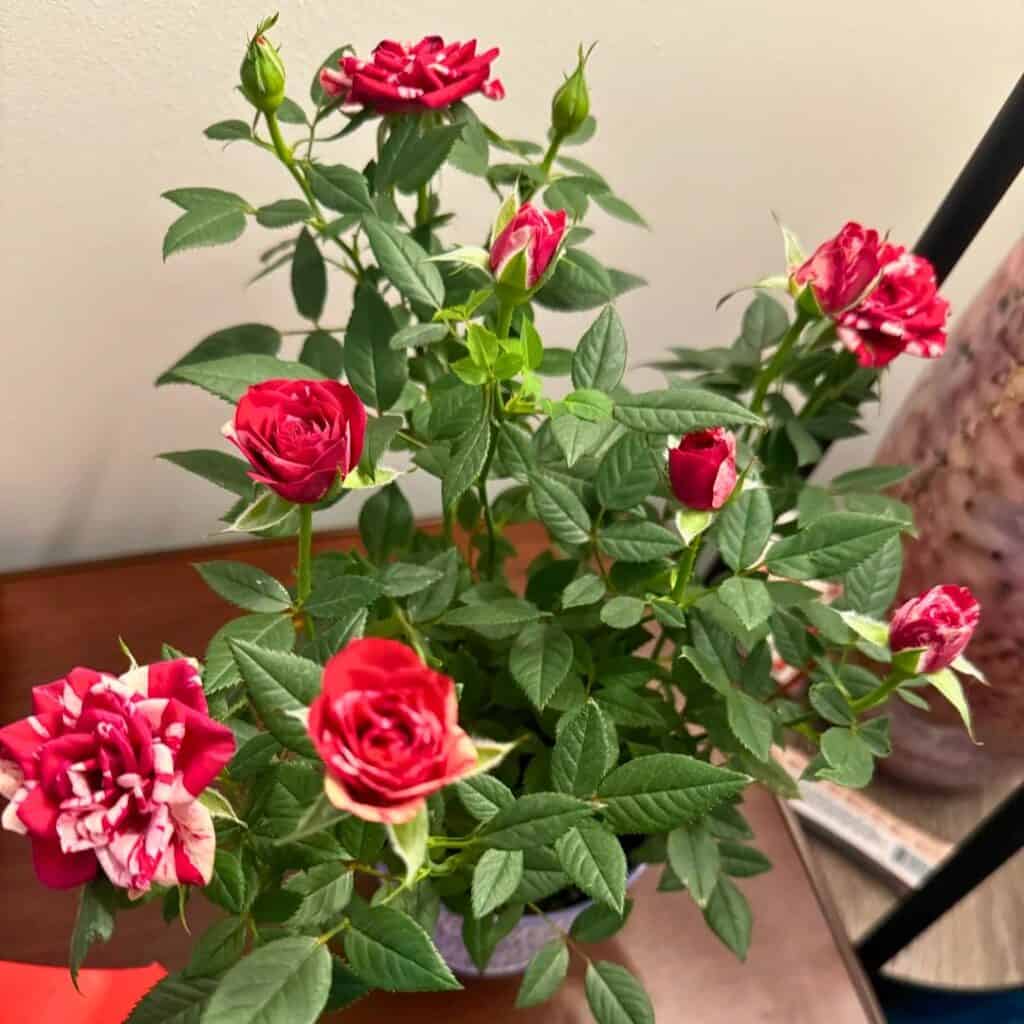
I’ve noticed that miniature roses need balanced light to grow straight. If I forget to turn the pot, the stems start leaning toward the window.
Rotating the pot keeps everything nice and even.
I just turn the pot a quarter turn once a week. It’s quick, and I try to do it on the same day each week so I don’t forget.
If one side looks paler or thinner, that’s my cue it’s not getting enough light. Regular rotation keeps growth even and the leaves a consistent color.
I keep my miniature roses near a bright window, but I don’t let them sit in the same spot for too long. Even light exposure helps the stems stay strong and the blooms balanced.
Sometimes I’ll stick a little sticker on the pot to remember which side faced the window last week. Consistency matters more than perfection, so I just do my best to turn the pot regularly.
8) Keep temperatures between 65-75°F (18-24°C)
From what I’ve seen, miniature roses really do their best when temperatures stay mild and steady. If the room hangs around 65-75°F (18-24°C), my plants seem happier and bloom more reliably.
Sudden swings in temperature? Not great. They stress out the roses and can slow everything down.
I try to keep my roses away from drafty windows, heaters, and air vents. Those spots tend to cause quick temperature changes that dry out leaves or buds before you know it.
A stable spot lets the plants focus on growing instead of recovering from stress.
In winter, I make sure it doesn’t dip below 60°F (15°C) in their room. If it gets chilly, I’ll sometimes use a little space heater nearby—but not too close. Consistent warmth keeps roots active and helps prevent leaf drop.
During the summer, I try not to let things get hotter than 80°F (27°C). If it does, I’ll crack a window or turn on a fan to keep the air moving. Airflow really helps balance things out and keeps mildew at bay.
I always check the temperature right by the plants, not just in the middle of the room. The area near a window can be a few degrees off. A small thermometer comes in handy for tracking and making those little adjustments.
Honestly, keeping the temperature right doesn’t take much work, but wow, it matters. My miniature roses look brighter, healthier, and they’re always ready to put on a show.
9) Use grow lights during shorter daylight months
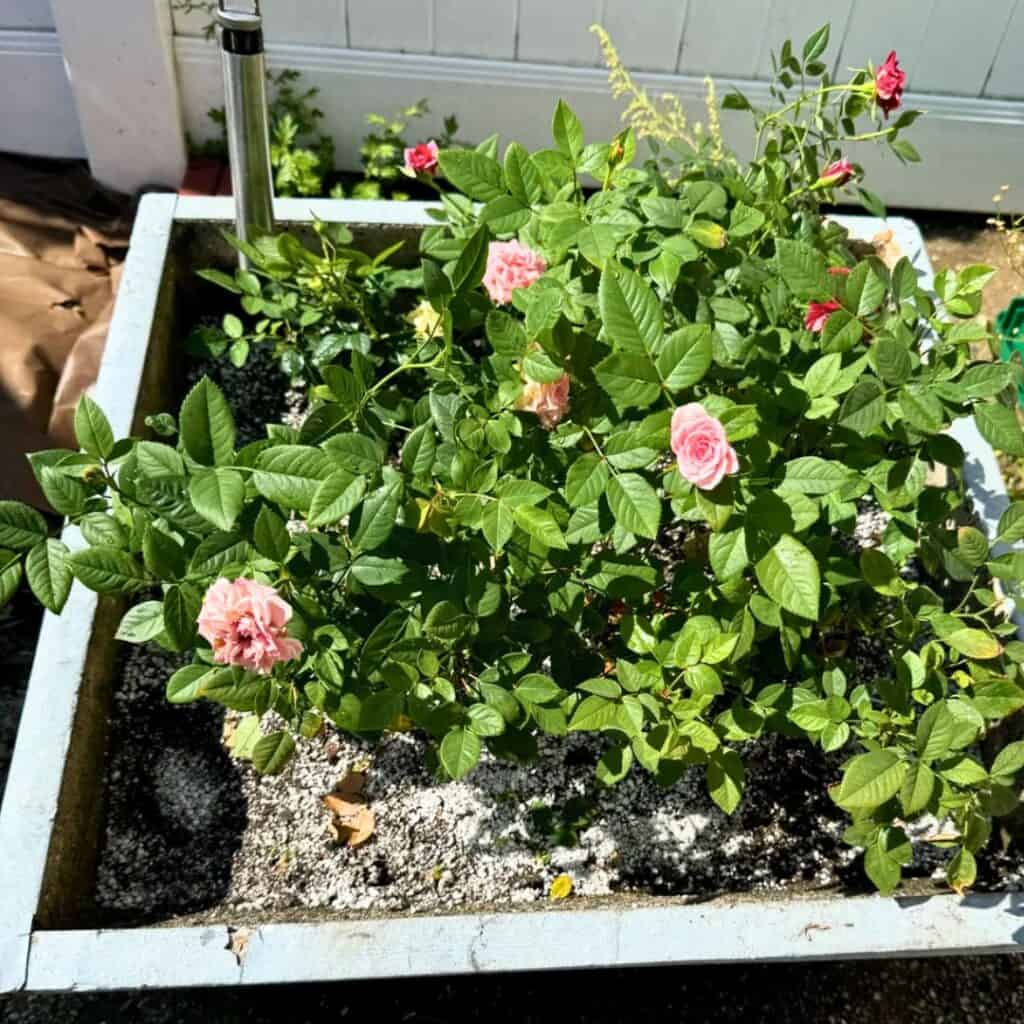
When winter hits, my miniature roses just don’t get enough sun. I use grow lights to keep them healthy and blooming. These lights fill in for the sunlight that disappears during those short days.
I set the lights about 6 to 12 inches above the plants. That distance keeps the leaves safe from burning but still gives them plenty of brightness. As the roses grow, I adjust the height so the light stays even.
The lights stay on for about 12 to 14 hours each day. Having a timer helps me keep it consistent, so my roses get the same light every day. Regular light keeps their growth steady and helps avoid those weak, stretched-out stems.
I’m a fan of LED grow lights—they use less energy, don’t get too hot, and last a long time. My roses look greener and push out more buds with them.
If I notice my plants leaning toward the light, I’ll rotate the pots every few days. It helps them grow evenly and keeps their shape looking good.
Even with the grow lights, I still open the curtains on sunny days. Natural light adds something extra and keeps the plants strong. Mixing sunlight with artificial light seems to give my roses the best results.
Grow lights have made it possible to enjoy my miniature roses all year. They stay bright and cheerful, even when it’s gloomy outside.
10) Repot every 2 years in fresh soil
I repot my miniature roses every couple of years to keep them healthy and growing strong. Fresh soil gives the roots a boost of nutrients and better drainage, which really helps the plant stay vibrant.
Old soil gets compacted and loses its punch over time. I’ll usually notice roots circling the pot or poking out of the drainage holes—clear signs it’s time for an upgrade and a slightly bigger pot.
When it’s repotting time, I gently pull out the plant and shake off the loose soil. I trim away any dead or tangled roots before settling the rose into its new home. Drainage holes are a must—nobody wants soggy roots.
I use a fresh, well-draining mix made for roses or flowering plants, pressing it lightly around the roots and leaving some space at the top for watering. Once it’s all set, I water thoroughly to help the plant settle in.
After repotting, I keep the rose in bright, indirect light for a few days so it can recover and adjust. No fertilizer right away—the new soil already has everything it needs.
Regular repotting keeps my miniature roses blooming longer and growing fuller. It’s a pretty simple step, but it makes a huge difference in how healthy and good-looking they stay.
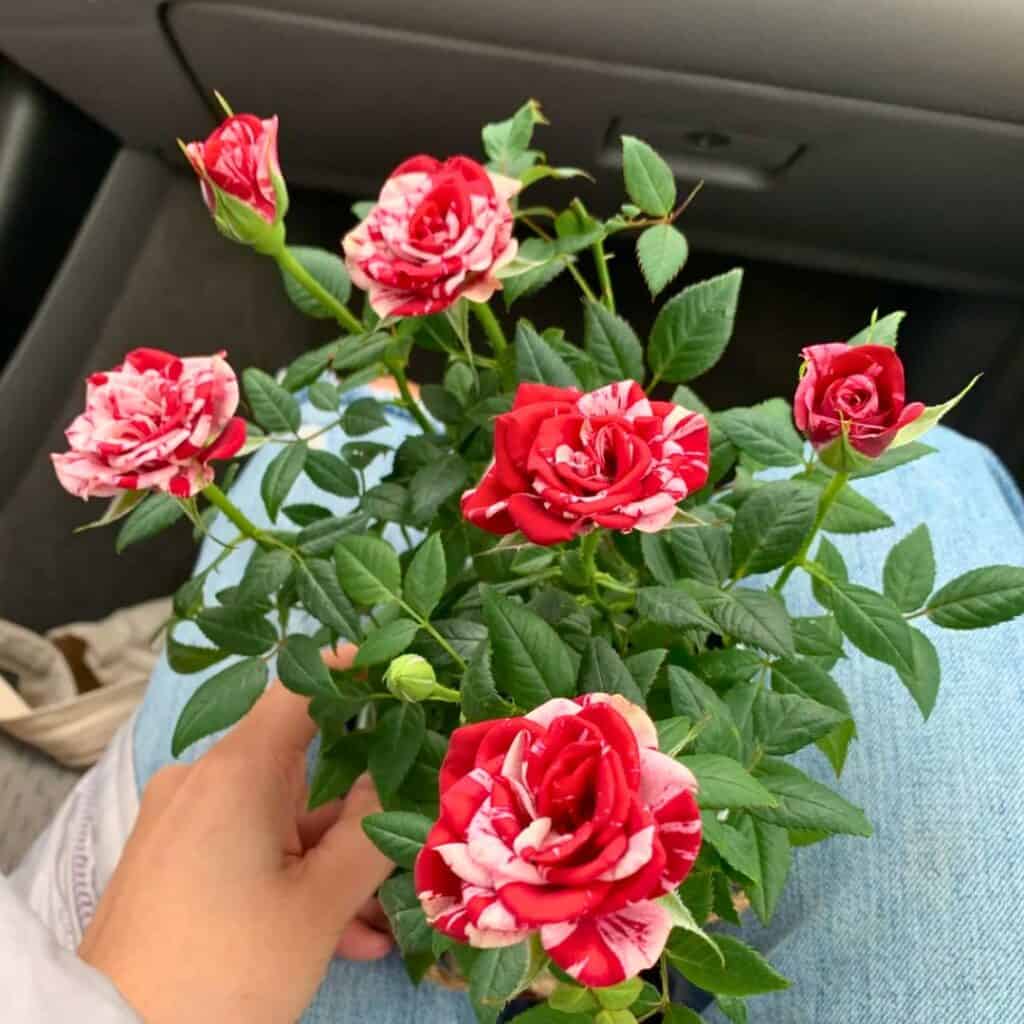
Optimizing Indoor Conditions for Miniature Roses
I keep my miniature roses happy by giving them strong light, steady temperatures, and fresh air. These basics help the plants grow compact and bloom often, without getting leggy or dropping leaves.
Choosing the Right Location
I put my miniature roses somewhere they get at least 5 to 6 hours of direct sunlight every day. South-facing windows are my favorite—they just seem to offer the best, steadiest light. If there’s not enough sun, I’ll switch on a full-spectrum grow light so the plants don’t get spindly.
The pots stay near the window, but I’m careful they’re not right up against cold glass in winter. Every few days, I turn the plants so all sides get their share of light.
A table or shelf near a sunny window keeps the roses at eye level and makes watering less of a hassle. I avoid spots by drafty vents or heaters—those dry out leaves fast.
| Light Source | Ideal Duration | Notes |
|---|---|---|
| Sunlight (south window) | 5–6 hours | Rotate plants often |
| Grow light | 10–12 hours | Keep 6–8 inches above plants |
Managing Temperature and Humidity
I shoot for a temperature between 65°F and 75°F (18°C–24°C) during the day, a bit cooler at night. Sudden changes are stressful, so I keep them away from doors or vents.
Miniature roses like moderate humidity, around 40–50%. If the air feels dry, I’ll use a small humidifier or set a tray of water with pebbles by the pots. The water gently evaporates and adds some moisture.
I check the leaves now and then. Crispy or dull leaves usually mean the air’s too dry. Keeping humidity steady helps prevent spider mites and keeps new buds from drying out.
Ensuring Proper Air Circulation
Good air movement keeps leaves dry and helps avoid mold or mildew. I use a small fan on low to keep the air moving gently around the plants.
I never point the fan right at the roses. Instead, I just let it move air around the room so the soil doesn’t dry out too fast.
I also space the pots at least a few inches apart so the leaves aren’t touching. This gives each plant room to breathe and makes it easier to spot early signs of pests or disease.
Clean air and a little space really do help. My roses stay greener, and their blooms just seem to last longer when the air’s fresh and balanced.
Troubleshooting Common Indoor Rose Challenges
Miniature roses can be a bit sensitive to their environment. They’ll run into pests, yellowing leaves, or stress if something’s off. Catching issues early helps keep them healthy and blooming.
Dealing With Pests and Diseases
I run into spider mites, aphids, or powdery mildew on my indoor roses sometimes. These pests love dry air and weaker plants. I check the leaves every week, especially underneath, for bugs or white spots.
When I spot pests, I’ll wipe the leaves with a damp cloth or spray them with insecticidal soap. For mildew, I focus on better air circulation and avoid getting the leaves wet when watering.
Here’s a quick cheat sheet I use:
| Problem | Cause | Quick Fix |
|---|---|---|
| Aphids | Dry air, weak growth | Spray with mild soap solution |
| Spider mites | Low humidity | Mist leaves daily |
| Powdery mildew | Poor airflow | Trim crowded stems and increase light |
Keeping the roses clean and in good light usually stops pest problems before they get out of hand.
Addressing Leaf Drop and Yellowing
If my roses start dropping leaves or turning yellow, it’s usually too little light, overwatering, or a nutrient imbalance. First thing I do is check the soil. If it’s soggy, I let it dry out before watering again.
I move the plant to a south-facing window or set up a grow light for 12–14 hours a day. Consistent light keeps the leaves green and sturdy.
If pale leaves stick around, I use a balanced liquid fertilizer every couple of weeks during the growing season. I skip feeding in winter when the plant’s resting.
Usually, just tweaking water and light stops leaf loss in a week or two.
Reviving Stressed Miniature Roses
Sometimes, even after doing everything right, my roses look wilted or tired. It’s often after repotting, temperature swings, or a spell of dry air. I trim away dead stems and faded blooms so the plant can focus on new growth.
I move the pot to a spot with bright, indirect light and keep the temperature steady—65–75°F is my sweet spot. Misting the leaves lightly helps bump up the humidity.
If the soil feels packed tight, I gently loosen it so the roots can breathe. In a few weeks, I usually see new buds, and the rose perks right back up.
Frequently Asked Questions

There are a few basics I always come back to with miniature roses. Good soil, a sensible watering routine, steady light, and a little pruning go a long way for healthy, blooming plants.
What type of soil is best for indoor miniature roses?
I use a well-draining cactus or rose potting mix. It keeps roots from sitting in water and helps prevent rot. If the mix has a bit of perlite or sand, even better for airflow.
How often should I water my miniature roses inside?
I water when the top inch of soil feels dry. Too much water leads to root rot, but letting the soil dry out completely stresses the plant. I check the soil often, especially in warmer rooms.
What’s the ideal indoor temperature for growing healthy miniature roses?
I keep my roses in rooms between 65°F and 75°F during the day, a little cooler at night. They’re not fans of big temperature swings or drafts from vents and windows.
How can I ensure my indoor miniature roses get enough light?
I keep mine by a bright, south-facing window for at least six hours of sunlight a day. If natural light is lacking, I’ll use a small grow light to help them along.
What are the common pests to look out for on indoor miniature roses?
I watch for aphids, spider mites, and whiteflies. Checking leaves often and wiping them with a damp cloth keeps pests in check. If things get bad, I’ll use insecticidal soap.
How do I prune miniature roses that are grown indoors?
I usually snip off any dead or yellowing leaves, and I’ll trim back stems that are getting too long or tangled.
After the roses finish blooming, I like to give them a little shaping—helps keep them looking tidy and, honestly, seems to encourage some fresh growth.
Recommended Garden Supplies
| Product Image | Our Recommended Gardening Supplies | Check Offers! |
|---|---|---|
Top Top
Top
Top
Top
Top
Top
Top
Top | rePotme Houseplant and Tropical Classic Potting Soil Mix | Check Offer On Amazon |
 Top
Top
Top
Top
Top
Top
Top
Top | Espoma Organic Indoor Plant Food | Check Offer On Amazon |
 Top
Top
Top
Top
Top
Top
Top
Top | GooingTop LED Grow Light 6000K Full Spectrum Clip Plant Growing Lamp | Check Offer On Amazon |
 Top
Top
Top
Top
Top
Top
Top
Top | Soil Moisture Meter | Check Offer On Amazon |
 Top
Top
Top
Top
Top
Top
Top
Top | Govee Hygrometer Thermometer, Bluetooth Enabled! | Check Offer On Amazon |
 Top
Top | LEVOIT Humidifiers for Large Room(Best For Plants) | Check Offer On Amazon |
 Top
Top
Top
Top
Top
Top
Top
Top | Upgraded DIY Automatic Drip Irrigation Kit, 15 Potted Houseplants Support | Check Offer On Amazon |
 Top
Top
Top
Top
Top
Top
Top
Top | Stainless Steel Heavy Duty Gardening Tool Set | Check Offer On Amazon |
 Top
Top
Top
Top
Top
Top
Top
Top | Bonide Insecticidal Soap | Check Offer On Amazon |
 Top
Top
Top
Top
Top
Top
Top
Top | Bonide 32 oz Spray Neem Oil for Organic Gardening | Check Offer On Amazon |
 Top
Top
Top
Top
Top
Top
Top
Top | Garden Safe Fungicide | Check Offer On Amazon |
Note: Some images in the articles are sourced from Reddit and Other Platforms For Reference Purpose.

